Discovering the world on a road bike is exhilarating, but ensuring a pain-free ride is crucial. To prevent shoulder pain while riding a road bike, mastering proper techniques and making necessary adjustments is key.
This comprehensive guide delves into effective strategies, encompassing ergonomics, posture, and exercises, enabling you to relish the road biking experience while keeping shoulder pain at bay.
Shoulder pain is something I experienced as a new rider. And while my issues weren’t serious, they certainly made riding less fun until I figured out how to improve my riding.
It took a multi-faceted approach to conquer my shoulder pain, including adjusting my bike fit, doing some strength training, and working on my posture.
With a little bit problem solving and some adjustments, I can now ride pain-free!
In this article, I will talk about how to fix shoulder pain on the bike. We’ll discuss some common causes and solutions and some common injuries.
Then, we’ll discuss how to prevent pain before it starts. But first, let’s look at the link between cycling and shoulder pain.
Key Takeaways: Prevent Shoulder Pain While Riding a Road Bike
- Road cyclists often experience shoulder pain due to their aggressive riding position and strain on the neck, upper back, and shoulders.
- Cyclists should focus on bike fit, posture, stretching, strengthening exercises, breaks, and pacing to prevent shoulder pain.
- Common signs of cycling shoulder pain include stiffness, tension, fatigue, and numbness/tingling.
- Common shoulder injuries in cyclists are rotator cuff tendinopathy, shoulder dislocation, and acromioclavicular joint injury.
- Try strengthening exercises for the upper back, shoulder girdle, and core muscles to improve shoulder pain.
The Link Between Cycling and Shoulder Pain
Road bikes feature a more aggressive riding position, which puts riders in a forward-leaning position on the bike.
Depending on the cyclist’s flexibility and core strength, this aggressive position may put too much tension and strain on the rider’s neck and upper back, affecting the shoulders.
If the cyclist doesn’t have enough core strength to maintain the position, they may put too much body weight on the arms or lock out the elbows, which causes additional pain and tension on the shoulders.
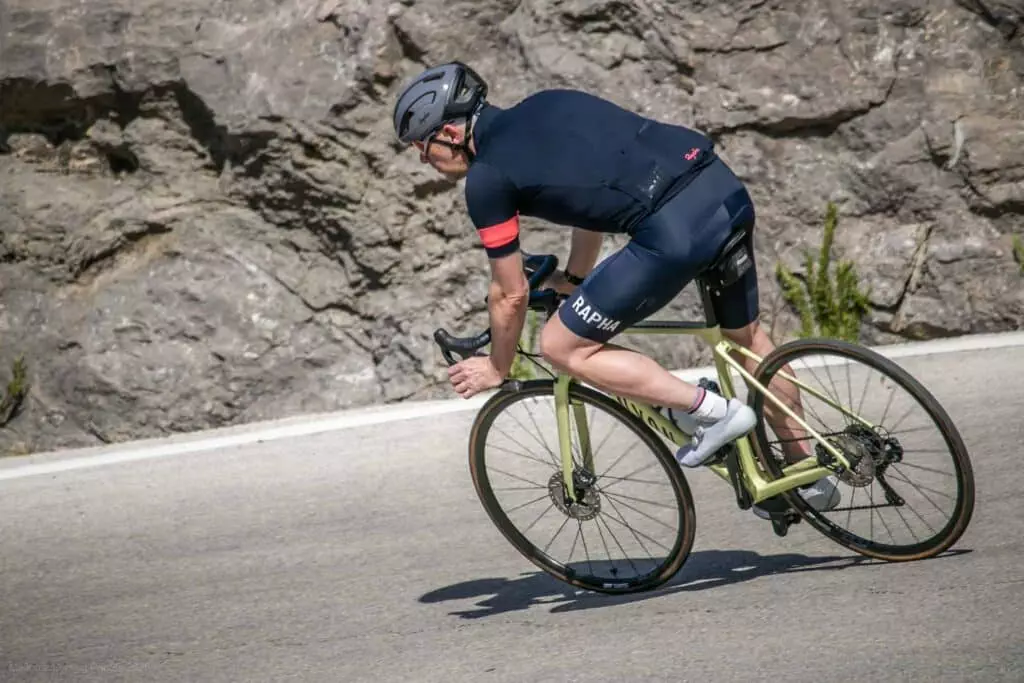
If you are experiencing shoulder pain when you are riding or if you want to prevent it before it starts, consider the following:
- Bike fit: Getting a professional bike fit is one of the most effective ways to remedy shoulder pain. A good bike fitter can ensure your bike is the right size and geometry.
They’ll ensure that the handlebars, saddle height, and tilt are set up to make you comfortable on the bike. - Posture: Good posture will also help you prevent shoulder pain.
First of all, don’t lock your elbows. Instead, keep them slightly bent. This will absorb some of the shocks in the road and reduce the stress on your shoulders.
Try to keep your shoulders relaxed – many cyclists squeeze their shoulders together or up towards their ears when riding, which can cause discomfort. - Stretching and strengthening: Regular stretching and strengthening exercises can help improve flexibility and muscle balance, reducing the risk of injury and pain.
For example, exercise to strengthen your core will allow you to hold your body in the correct position so you don’t lean into the handlebars too much. - Take breaks: Adjust your position often while riding. Also, take breaks during long rides and give yourself days off from riding.
By addressing these factors, you can prevent shoulder pain and continue to enjoy your road biking adventures!
Signs of Cycling Shoulder Pain
Shoulder pain while riding can present in various ways.
For example, if you are too stretched out on the bike, reaching toward the handlebars will pull your shoulders forward. This may show up as stiffness in the upper back or tension between the shoulder blades.
If your bike doesn’t fit you well or your saddle position is off, then over time, the pressure can build up in your shoulders.
If you feel fatigued in your shoulders, you might be gripping the handlebars too hard without realizing it. This causes fatigue, strain, and even pain.
Numbness in the hands and fingers is very common in cyclists. It may radiate from the shoulders and even into the neck or upper back.
In more severe cases, you may notice numbness, tingling, or pain that radiates from the shoulder to other areas, such as the trapezius muscle or neck.
These symptoms can indicate misaligned shoulder joints and poor riding posture.
What Are 3 Common Shoulder Injuries Seen in Cyclists?
Road cycling can lead to several shoulder injuries. Knowing about these common injuries can be helpful in prevention and treatment. Here are three frequent shoulder issues that cyclists may encounter:
- Rotator Cuff Tendinopathy occurs when the rotator cuff muscles and tendons are strained due to the cycling posture, placing an imbalanced demand on the shoulders (source).
Strengthening the shoulder muscles and maintaining proper cycling posture can help prevent rotator cuff tendinopathy. - Shoulder Dislocation: Falling off a bike can result in shoulder dislocation, either anterior or posterior (source). Easy to say, but not falling off your bike can help reduce the risk of dislocations!
- Acromio-Clavicular Joint Injury: Another injury that can occur after a fall is an injury to the acromioclavicular (AC) joint. Recovering from an AC joint injury may require rest, rehabilitation, and in severe cases, surgery.
How To Prevent Shoulder Pain While Riding A Road Bike
There are three main topics to focus on when solving shoulder pain – The Bike, Riding Technique, and Your Body. Let’s take a look at each of these in more detail.
1. Proper Bike Fit
Getting the right bike fit prevents shoulder pain and enables you to enjoy rides.

Handlebar Height
Adjusting the handlebar height ensures a relaxed and comfortable riding posture, reducing strain on your neck and shoulders.
For example, if you are a recreational rider, you’ll probably want your handlebars even with the seat or slightly below. Here’s how to set up your handlebars.
Saddle Position
Experiment by moving your saddle back and forth until you achieve a well-balanced position, making it easier to hover your hands over the bars.
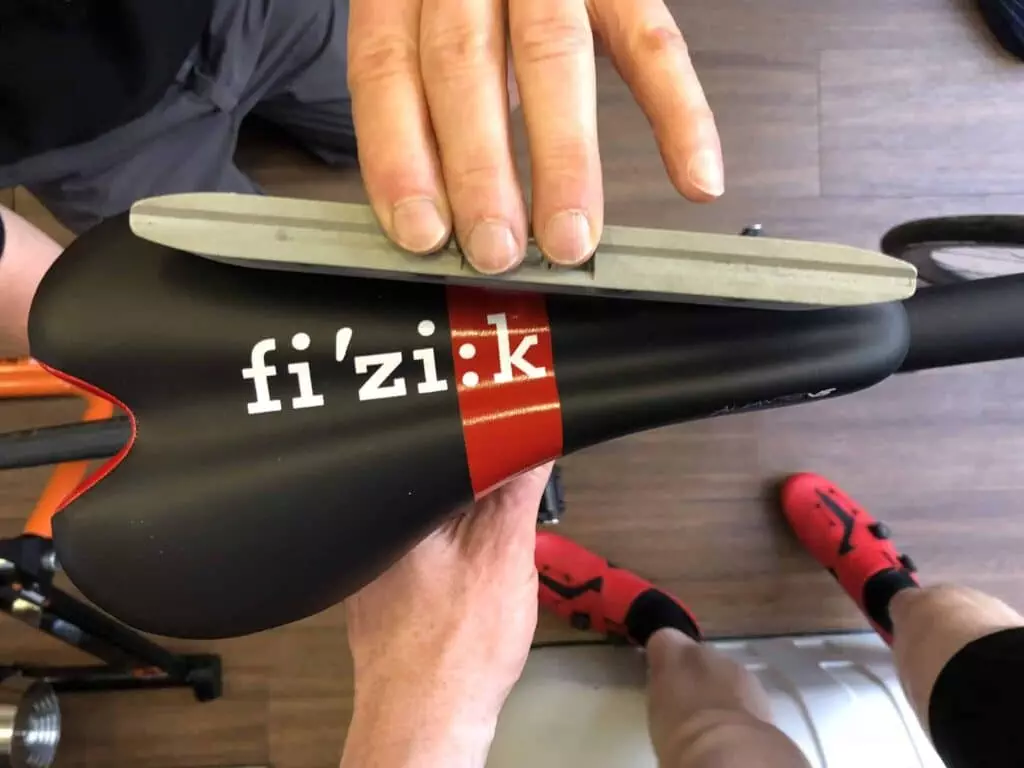
Reach Distance
Simply put, the distance between where you sit on the saddle and where you hold onto the bars is called ‘the reach.’
If your reach is too stretched out, or you are getting too low in your position can put tension on the shoulders, causing pain.
You may need to raise the handlebars or move the saddle and adjust the stem to make the reach more comfortable.
2. Improve Your Riding Technique
Preventing shoulder pain while riding a road bike is essential for a comfortable and enjoyable experience. Let’s dive into some techniques!
Engaging Your Core
When you ride, you use your core to stabilize your position on the bike. Strengthening your core will make it easier to sit comfortably on the bike and take some pressure off your hands.
The coaches I have worked with always recommend core exercises for stability, comfort, and injury prevention.
Ride with Good Posture
We all know we need to sit and stand with good posture, but good posture on the bike is important, too. Being hunched over, bunched, stretched, or not in a good position will cause stress and strain your body.
Keep your shoulders back and down, with your head out in front, like a turtle! Hunching your shoulders up to your ears will cause more pain.
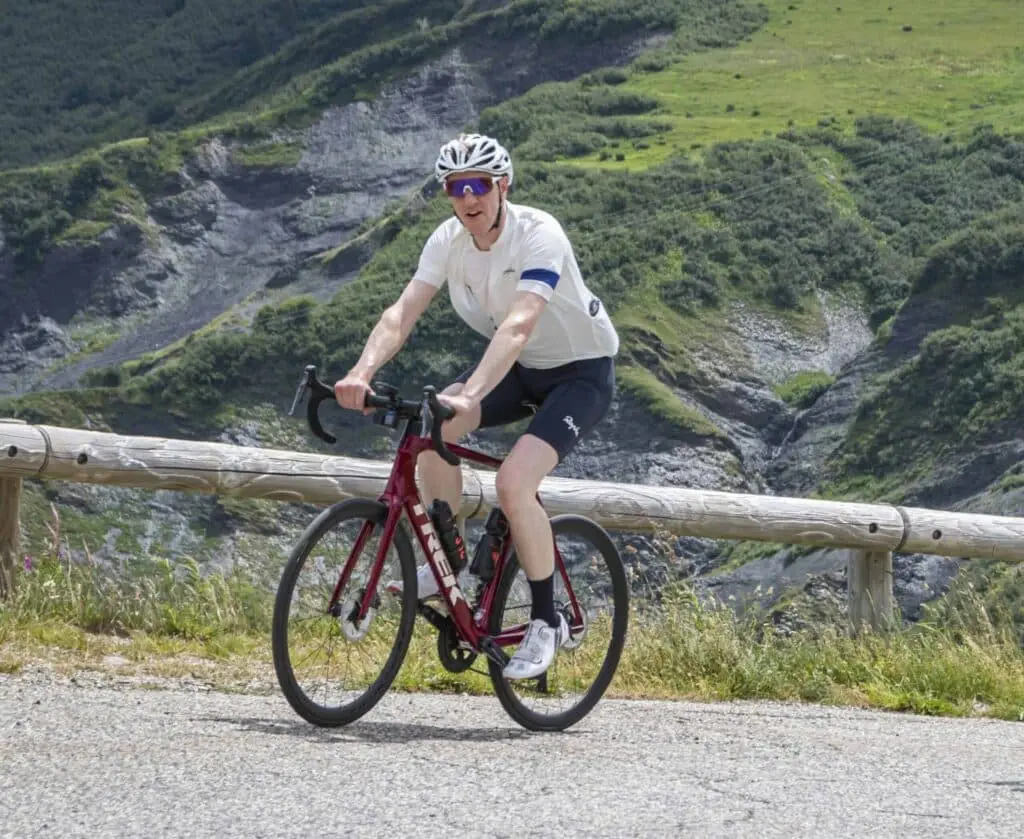
Relax Your Grip
A tight grip on the handlebars can lead to unnecessary shoulder tension. Relax your grip and only apply enough pressure to maintain control.
Regularly check in with yourself to see if you are tense or gripping too tightly. Remind yourself to relax – not only will it feel better, but you’ll also have better control of the bike.
On-Bike Technique Tips:
- Alternate hand positions regularly
- Shift your weight occasionally
- Keep wrists aligned with forearms
- Beware of tensing your shoulders
Remember to listen to your body! Rest if needed, and adjust your cycling habits if you experience pain or discomfort. Prevention is better than nursing an injury.
3. Strengthening Exercises
Let’s dive into some practical strengthening exercises to keep your shoulders pain-free while cycling!
Upper Back
Target your upper back muscles with exercises like:
- Face pulls
- Seated row
- Band pull-aparts
These will help to maintain proper posture and prevent hunching while riding.
Shoulder Girdle
Focus on shoulder girdle strength and stability with:
- Push-ups
- Scapular retractions
- Rotator cuff exercises
This will improve your shoulder endurance and control during long rides.
Core Muscles
A strong core is essential for overall cycling performance:
- Planks
- Dead bugs
- Bicycle crunches
These exercises will help to maintain proper spinal alignment, reducing the strain on your shoulders.
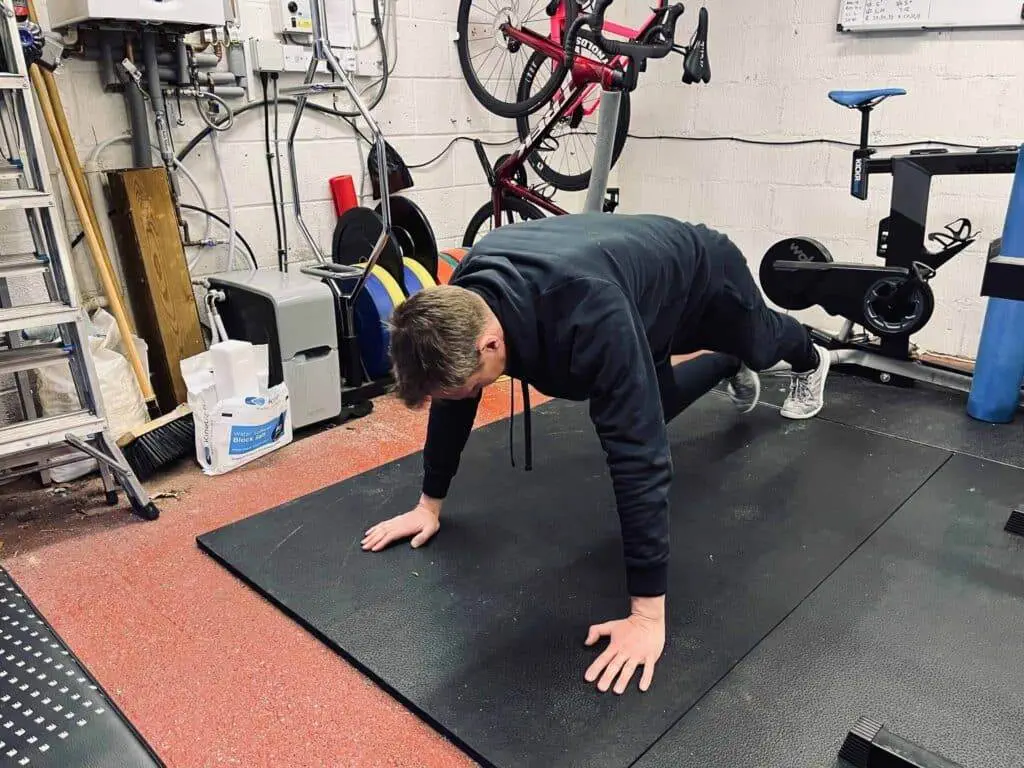
4. Stretching for Flexibility
Post-Ride Stretches
Try a few different shoulder stretches post-ride, for example, wall climb, chest and shoulder stretch, and shoulder stretch with rotation.
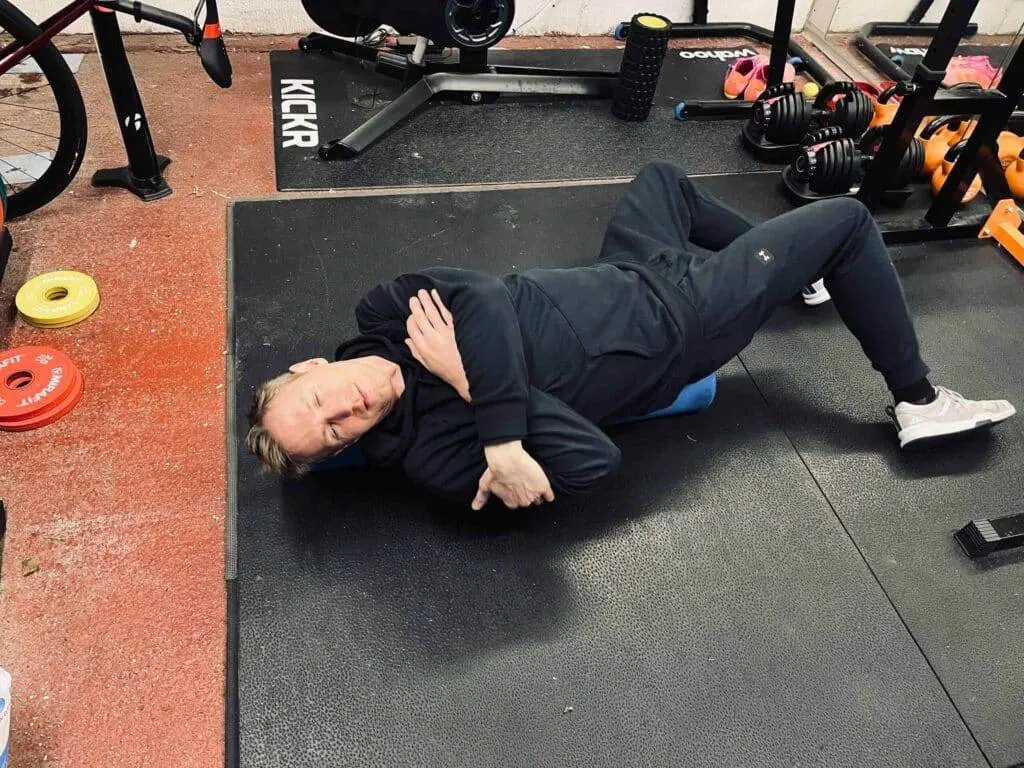
Daily Stretching Routine
Incorporate daily stretches into your routine. Hold each stretch for at least 15 seconds to improve your flexibility.
Stretches like these can help prevent shoulder pain and maintain flexibility for enhanced cycling performance. Remember, consistency is key!
5. Pace Yourself
Doing too much riding at once or doing too much riding too soon can exacerbate pain or injuries, even old ones. Pacing yourself and working up to longer rides can help prevent injury. For example: :
- Frequent breaks: Allow your muscles to recover by taking short breaks during your ride.
- Adjust your hand position throughout the ride.
- Gradual progress: Gradually increase the length and intensity of your rides to avoid overloading your muscles.
Following these pacing tips will reduce the likelihood of shoulder pain, and you’ll enjoy a more comfortable ride!
How to Tell If You Have Healthy Shoulders?
First, check your range of motion by lifting your arms above your head and behind your back. A healthy shoulder should allow full movement without pain.
Observe posture: Good alignment with a relaxed upper back and shoulders suggests healthy shoulders. Slumped posture might hint at potential issues.
To test your strength, try performing exercises like push-ups and shoulder presses. Your shoulder strength is likely good if you can perform these without pain.
Another sign of healthy shoulders is the absence of clicking, grinding, or other abnormal noises during movement. Unusual sounds could indicate problems.
Finally, take note of any pain or stiffness while riding. Persistent pain shouldn’t be ignored, as it may be an early sign of an issue.
Final Thoughts on Cycling and Shoulder Pain
Shoulder pain on the bike isn’t normal; you shouldn’t just accept it! There are so many things you can do to correct and prevent it.
- Check your bike fit
- Check your bike posture
- Strengthen and stretch your muscles
- See your doctor if you have an injury or continued pain
Incorporate these strategies so you can ride pain-free!
FAQs
Can cycling give you shoulder pain?
Yes, cycling can cause shoulder pain due to repetitive motion and prolonged periods spent in a forward-leaning position. The upper body’s weight can pressure the shoulders, leading to muscle tension and pain.
Additionally, poor posture and incorrect bike fit can exacerbate the problem. Addressing discomfort or pain early on is essential to prevent further injury or chronic issues.
How do I stop my neck and shoulders from hurting when cycling?
The discomfort in your neck and shoulders while cycling can be alleviated by adjusting your bike and posture.
Firstly, ensure that your bike fits your body size and riding style correctly. This will help distribute your weight evenly and reduce strain on your neck and shoulders.
Secondly, adjust your handlebars and saddle height to a comfortable position that allows you to maintain a relaxed posture.
Additionally, take breaks and regularly stretch while riding to prevent muscle stiffness and tension. Finally, consider doing exercises that strengthen the muscles in your neck and shoulders to help support your body while cycling.
How do I relax my shoulders when cycling?
Relaxing your shoulders while cycling can help reduce tension and prevent pain. One way to do this is to focus on your posture and position on the bike.
Avoid gripping the handlebars too tightly, and keep your shoulders relaxed and down. Take breaks and stretch regularly to prevent stiffness and tension in your muscles.
What exercises for cycling shoulder pain?
Exercises that help alleviate shoulder pain while cycling include strengthening and stretching exercises for the neck, shoulders, and upper back muscles.
Some recommended exercises include shoulder shrugs, blade squeezes, and arm circles. Chest and neck stretches can also help loosen tight muscles and improve flexibility.
Yoga and Pilates can also improve posture and strengthen the muscles that support your body while cycling.
How do I strengthen my shoulders for cycling?
Strengthening your shoulders can help improve your posture and reduce the risk of pain and injury while cycling.
Some exercises that can help strengthen the muscles in your shoulders include shoulder presses, lateral raises, and front raises.
Additionally, push-ups, pull-ups, and rows can help build upper body strength, benefiting your cycling performance.
Resistance bands can also be used to perform various exercises that target the shoulders. It’s essential to start with light weights or resistance and gradually increase as you build strength.
You may want to talk to a coach, physical therapist, or trainer to help you choose the right exercises for your situation.
